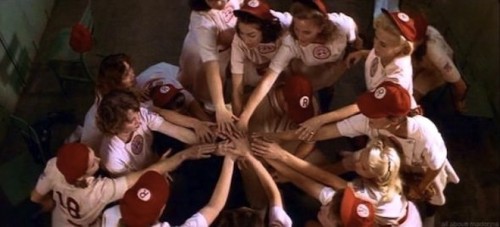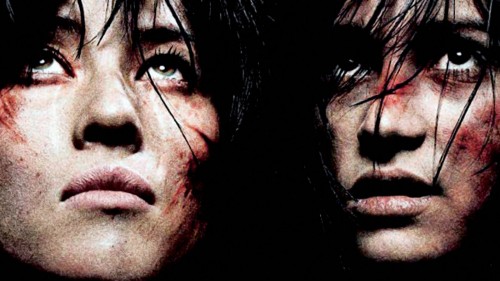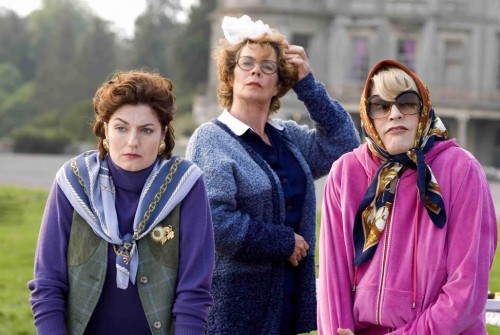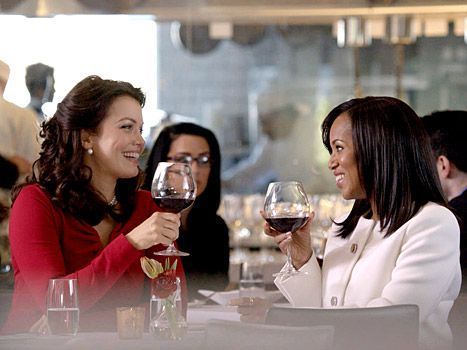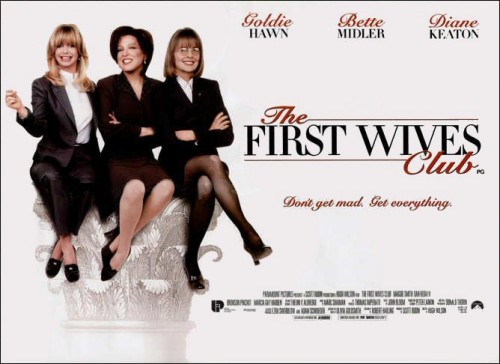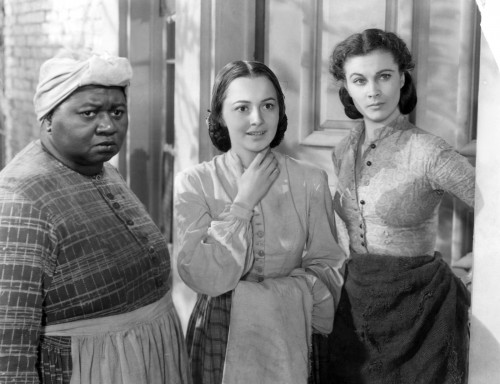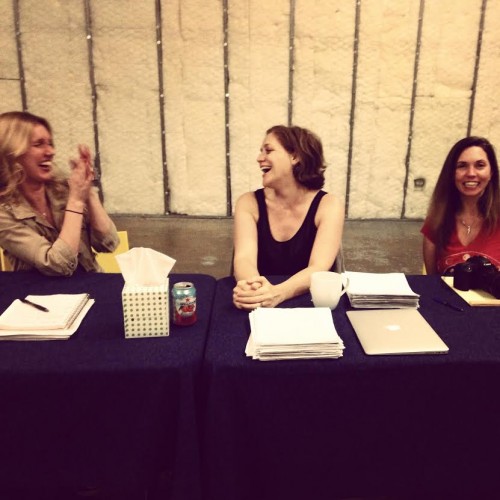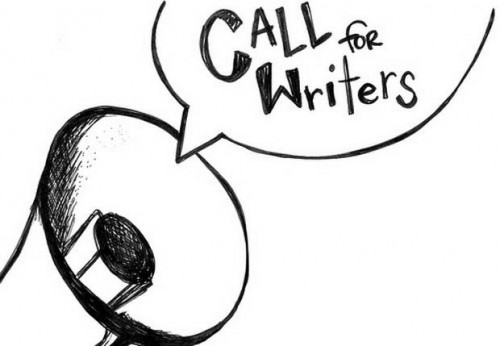This guest post by Rhianna Shaheen appears as part of our theme week on Female Friendship.
I’ve seen quite a few female friendships on screen that I’ve liked, but I never get tired of A League of Their Own (1992). As an alumna of a women’s college, this film especially hits home, making me nostalgic for my Bryn Mawr days. Each time I watch it I become homesick for that place and that community where we were all young pioneers in our own way. I often project myself onto older Dottie, imagining myself old and grey at my class reunion in a similar fashion to the film’s ending sequence. Instant tears!
While narratives about groups or duos of female friends are common to the “chick flick” genre, large and diverse casts of women seem to be a rarity in film and TV unless it’s high school rivalries or incarcerated women. Not only does this provide us with a limited scope of representation but it also perpetuates harmful stereotypes that affect young women as well as a society that equates women’s leadership to being “bossy” or “pushy.”
The media’s portrayal of women and female friendships is too often characterized by catfights and “bitchiness” toward each other in the competition for a man. These harmful images of girls and women have become so pervasive to our culture that large communities of women are often viewed as detrimental to progress or success. Male friendships and communities are encouraged at a young age through sports teams and Boy Scouts, while communities of women are stigmatized by the patriarchy as “bitchy,” “too emotional,” or “too much drama.”
I myself was under a similar delusion before I applied to three of the Seven Sisters Colleges. Most people who tried to dissuade me either pointed to the lack of male students as being a deficit to my happiness or some other gross sexist, homophobic stereotype. A League of Their Own celebrates so much of what makes largely female communities special and the bond between the individuals so powerful.
A story told about the founding of women’s professional baseball could have taken many directions. I am thankful that it did not fall into any of those ugly stereotypes in order to propel the narrative. The women in this film have relationships with each other that are put first over any relationships they may or may not have with men. As a result, we have a film that provides us with three-dimensional portraits of women and the intricacies of their friendships during a time of transition in the 1940s.

When the Rockford Peaches first come together for their first ever game as a team they look to their manager and former baseball star Jimmy Dugan (Tom Hanks). To their surprise he treats the whole thing as a joke citing, “I don’t have ballplayers, I’ve got girls. Girls are what you sleep with after the game, not, not what you coach during the game.” He comes into the locker room drunk and completely useless. Without a lineup for the game, Dottie Hinson (Geena Davis) steps up and quickly assumes the role of coach for a good majority of the film. Despite a drunken manager and the sexist heckles from the empty stadium, these women pull together a lineup and easily win their first game.

As these women spend more time together they learn to grow as ballplayers and sisters. Many of my favorite scenes are the brief vignettes that occur throughout the film that give us a deeper glimpse into their lives and character. Early in the film, Dottie and her younger sister Kit (Lori Petty) stand up for Marla Hooch (Megan Cavanagh) when talent scout Ernie Capadino (Jon Lovitz) rejects her as possible player due to her plain looks. Both sisters refuse to go with him unless he accepts Marla, who is as good of a player as any of them. On the bus, Mae teaches her teammate Shirley how to read by having her sound out the words from a smutty novel. When asked about her choice of literature Mae responses: “What difference does it make? She’s reading, okay? That’s the important thing.” In the same sequence, Doris (Rosie O’Donnell) opens up about her abusive boyfriend back home to the other women. She discusses the importance of this league and the support of her teammates in shaping her own self-esteem: “I mean, look. There’s a lot of us. I think we’re all all right.” While these players may clash at times there is none of the cattiness or “girl hate” concocted by the patriarchy.

The next problem becomes the fact that the women’s league isn’t bringing enough fans into the stadium or profit to the owners of the league. When there’s talk of closing them down these women band together and “give them everything [they’ve] got” to save the league. A photo of Dottie doing the splits while catching a ball behind home plate hits the cover of Life magazine and the crowds soon follow. Even “All the Way” Mae brainstorms ways to help their publicity drive: “What if at a key moment in the game my, my uniform bursts open and, uh, oops…my bosoms come flying out? That, that might draw a crowd, right?” While the league’s owner, Mr. Harvey (Garry Marshall), is not convinced of its worth until after Kit has been traded off to another team, there’s no doubt that the camaraderie between these women singlehandedly kept morale high and saved major league baseball through World War II.


While A League of Their Own serves mostly as a “memory movie” in which Dottie relives the memory of something she thought “was never really important to [her],” the most satisfying part of the film has to be the fast-forward to the reunion. At the end, many of the league’s players reunite to be inducted into the National Baseball Hall of Fame. Old friendships rekindle and emotions soar. After following these women through what must have been the best time they ever had in their youth it is refreshing to see authentic portrayals of them as older women. It feels like their lives are unfolding before my eyes. As pioneers for women in sports, they become immortalized into history through an exhibit dedicated to them. However, it’s only when they sing their Victory Song that the unending power of their sisterly bond truly can be understood:
We are the members of the All-American League.
We come from cities near and far.
We’ve got Canadians, Irishmen and Swedes,
We’re all for one, we’re one for all.
We’re All-Americans!


While ALOTO is sometimes called the “ultimate chick flick of sports” I would challenge that notion.
1. That label is problematic in the larger scheme of film culture. “Chick flick” often suggests a plotline that centers on love and romance, which, excuse me, is extremely nebulous and could be any film. The way it is thrown around in “filmspeak” often implies frivolity and artlessness, making it taboo for film lovers to love or engage with these films. Even worse, is it argues that men and women are inherently different even though there is no equivalent for films geared toward male audiences, ostracizing the experiences of women or female lead stories.
ALOTO is rather a deconstruction of that very term, because it does not present the story of the first All-American Girls Professional Baseball League as the “male version” of x,y, or z movie but instead presents a true female experience in a little-known chapter of American sports history that all audiences can appreciate and find relatable.
2. A League of Their Own is an excellent film, with great direction by Penny Marshall, remarkable acting, and superb writing – it gave us some of the most memorable lines in film history. (“There’s no crying in baseball!”) My question is: how was this film not considered for ANY Academy Awards in 1993? The truth is that films about female friendships are still not taken seriously and condemned to the seemingly second-rate status of “chick flick.” Meanwhile, dude-friend movies (Good Will Hunting, The Shawshank Redemption, The Lord of the Rings) or dude-baseball movies (Field of Dreams, Moneyball) flourish and are considered universally hilarious (Dumb and Dumber, Anchorman, The Hangover) or Oscar-worthy.
While I could ruminate on this until my hair falls out, the truth is my energy would be better spent on the many stories still waiting to be told. I can only hope that A League of Their Own inspires others to believe as I do that the female bond is a powerful narrative arc worthy of being explored outside its current limited representation.

Rhianna Shaheen is a student filmmaker and artist with hopes of writing more in the future. She recently graduated from Bryn Mawr College with a BA in Fine Arts and Minor in Film Studies and Art History. She currently spends most of her time on an epic quest for a fulltime job. Check her out on twitter!
